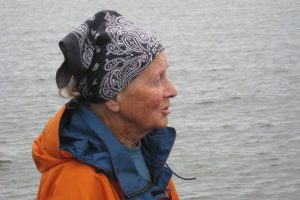“As an amateur I was beholden to nobody and could follow my inclinations and make my own decisions without the need to justify them to granting agencies, senior academics, or anybody else… ” (Pers. Comm. cited in Langenheim 1996)
 While the name Pielou may not immediately come to mind when considering mammalian reproductive biology, one would be hard-pressed to find an ecologist’s bookshelf devoid of at least one of her statistical books. Such is her contribution that her name is used for a measure of species evenness! Known more commonly as E.C. or ‘Chris’ Pielou – Evelyn Chrystalla Pielou was a mathematical and statistical ecologist who made enormous contributions to quantification and understanding of ecology as well as modeling natural systems both past and present. Equally fascinating is Dr. Pielou’s non-traditional life path. Given the huge influence of Pielou on the field of ecology and her uniqueness as a female scientist, she is included here. Pielou not only helped forge a new discipline, but did so as a part-time, self-taught, stay-at-home biologist!
While the name Pielou may not immediately come to mind when considering mammalian reproductive biology, one would be hard-pressed to find an ecologist’s bookshelf devoid of at least one of her statistical books. Such is her contribution that her name is used for a measure of species evenness! Known more commonly as E.C. or ‘Chris’ Pielou – Evelyn Chrystalla Pielou was a mathematical and statistical ecologist who made enormous contributions to quantification and understanding of ecology as well as modeling natural systems both past and present. Equally fascinating is Dr. Pielou’s non-traditional life path. Given the huge influence of Pielou on the field of ecology and her uniqueness as a female scientist, she is included here. Pielou not only helped forge a new discipline, but did so as a part-time, self-taught, stay-at-home biologist!
Pielou’s contributions are prodigious. She pioneered the field of multivariate statistics in ecological research. On the scholarly end, her books include, Introduction to mathematical ecology (1969), Population and community ecology: principles and methods (1974), Ecological diversity (1975), Mathematical Ecology (1977), Biogeography (1979), and the iconic (esoteric?) Interpretation of ecological data: a primer on classification and ordination (1984). Her writing also includes books for a general audiences such as World of northern evergreens (1984), After the ice age: the return of life to glaciated North America (1991), A naturalist’s guide to the arctic (1994), Fresh water (2000), and The energy of nature (2001).
Pielou was born in England but spent much of her career in Canada. As a young woman she entered the sciences with a certificate in radio-physics (at age 18) and subsequently completed three years of war service as a Navy technical assistant. Eventually she achieved her BS in Botany from the University of London. She published her first paper two years later and raised three children while continuing to publish on statistical ecology. Twelve years after her first publication and without an advisor, in 1962 she concatenated several of her excellent publications into a dissertation and was awarded a Ph.D. from the University of London (a mere formality given her obvious scholarly achievements by this point). She obtained a second Ph.D. in mathematical ecology (Maingon 2016). In 2001, she was also awarded an honorary Ph.D. from the University of British Columbia. In her acceptance address, she remarked “a person who blocks out math is a mental couch potato” (Maingon 2016). Pielou did not suffer fools gladly.
Impressively, Pielou invented the field of mathematical ecology (Gill 2012). Her Introduction to Mathematical Ecology “literally changed the direction of ecological research” (Bentley 1986:30). She also contemplated macroecology before it was broadly studied. When nearly 40, she took a job as a research statistician for the Canadian Departments of Forestry and Agriculture and began her paid academic career as a full professor at Queen’s University a few years later (1968-1971). Subsequently, she was employed at Dalhousie University in Halifax, Nova Scotia (1974-1981), and worked until retirement at the University of Lethbridge, Alberta (1981-1986).
In 1986, she was the second woman to be awarded the Eminent Ecologist Award from the Ecological Society of America (ESA) for forging the field of mathematical ecology. The first was in 1972 given to Ruth Patrick a freshwater wetlands specialist. Pielou did not hesitate to correct mathematical errors, even those of eminent ecologists, as exemplified by her published correction of an error by Robert MacArthur (Pielou, Arnason 1966). He did not seem to appreciate the correction (1966).
Pielou retired to Comox Valley, British Columbia, but retirement did not slow her productivity as she continued to write. These later books focused on making complicated subjects accessible to general audiences and include lovely drawings done by Pielou herself. Her books on the arctic and fresh water delve into the workings of the abiotic world. During retirement, Pielou actively worked for conservation issues and was instrumental in having the Clayoquot Sound designated as a United Nations Biosphere Reserve. She also participated in arctic expeditions and served as a scientific advisor for ecotourism. In her honor, ESA has a graduate student award for Statistical Ecology.
Photo is with permission of the Comox Valley Naturalists from a 2011 walk at the Goose Spit at the mouth of the Comox Bay during which Dr. Pielou expounded on the post-glacial history of the estuary (Loys Maingon, pers comm).
References:
Bentley, B. 1986. Eminent ecologist, E.C. Pielou. Bulletin of the Ecological Society of America 68:30-31.
Gill, J. 2012. Happy Ada Lovelace Day! Honoring Dr. Evelyn Chrystalla Pielou. https://contemplativemammoth.com/2012/10/16/happy-ada-lovelace-day-honoring-dr-evelyn-chrystalla-pielou/. Accessed 10 August 2016.
Langenheim, J. H. 1996. Early history and progress of women ecologists: Emphasis upon research contributions. Annual Review of Ecology and Systematics 27:1-53.
Maingon, L. 2016. Comox Valley loses a tiny giant of an environmentalist. http://tidechange.ca/2016/07/20/comox-valley-loses-tiny-giant-environmentalist/. Accessed 10 August 2016.
Pielou, E.C., A.N. Arnason. 1966. Correction to one of MacArthur’s species-abundance formulas. Science 151:592.
MacArthur, R. 1966. Note on Mrs. Pielou’s Comments. Ecology 47:1074.
(Text from Reproduction in Mammals: The Female Perspective, Hayssen and Orr 2017)